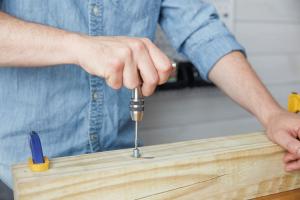How to Effectively Remove a Screw Without a Head: Tips and Techniques

-
Quick Links:
- Introduction
- Understanding Screws
- Why Screw Heads Break Off
- Tools Needed
- Preparation Steps
- Methods to Remove a Screw Without a Head
- Method 1: Rubber Band Technique
- Method 2: Screw Extractor Set
- Method 3: Drilling a New Hole
- Method 4: Using Pliers
- Method 5: Cutting a Slot
- Case Studies and Real-World Examples
- Expert Insights and Tips
- FAQs
Introduction
Removing a screw without a head can be a frustrating task for DIY enthusiasts and professionals alike. Whether it's due to wear, rust, or improper installation, a missing screw head can halt a project and lead to costly delays. In this comprehensive guide, we will delve into various methods, tools, and expert tips to help you effectively remove those pesky screws without heads.
Understanding Screws
Screws are one of the most common fasteners used in construction and repair projects. They come in various sizes and types, each designed for specific applications. Understanding the anatomy of a screw, including its different parts such as the head, shaft, and threads, is crucial for effectively removing one without a head.
Why Screw Heads Break Off
There are several reasons why screw heads may break off, including:
- Over-tightening: Applying excessive torque during installation.
- Corrosion: Rust and other environmental factors can weaken screws.
- Material fatigue: Repeated stress can lead to failure.
Tools Needed
Before attempting to remove a screw without a head, gather the following tools:
- Rubber bands
- Screw extractor set
- Drill and drill bits
- Pliers (needle-nose or locking)
- Hacksaw or Dremel tool
- Hammer
- Safety goggles
Preparation Steps
Follow these preparation steps to ensure a successful screw removal:
- Assess the situation: Identify the type of screw and its location.
- Gather tools: Ensure you have all necessary tools at hand.
- Wear safety gear: Protect your eyes and hands while working.
Methods to Remove a Screw Without a Head
Method 1: Rubber Band Technique
This simple method utilizes the grip of a rubber band to help extract the screw.
- Place a rubber band over the screw stub.
- Firmly press a screwdriver into the rubber band and turn.
- The rubber band will provide extra grip, allowing you to turn and remove the screw.
Method 2: Screw Extractor Set
A screw extractor is a specialized tool designed to remove broken screws.
- Drill a small hole into the center of the screw.
- Insert the screw extractor into the hole.
- Turn counterclockwise to remove the screw.
Method 3: Drilling a New Hole
If other methods fail, you can drill a new hole around the screw.
- Use a drill bit slightly larger than the screw shaft.
- Drill around the screw stub, making sure not to damage surrounding material.
- Once enough material is removed, you can pull out the screw.
Method 4: Using Pliers
Pliers can be effective for gripping and twisting stubs that are exposed enough.
- Use needle-nose or locking pliers to grip the screw stub.
- Turn the pliers counterclockwise to remove the screw.
Method 5: Cutting a Slot
If the screw is stubborn, you can create a slot for a flathead screwdriver.
- Use a hacksaw or Dremel tool to cut a shallow slot in the screw.
- Insert a flathead screwdriver into the slot and turn.
Case Studies and Real-World Examples
To illustrate the effectiveness of these methods, let’s examine a few case studies:
- Case Study 1: A homeowner used the rubber band technique to successfully remove a broken screw in a wooden frame.
- Case Study 2: A mechanic employed a screw extractor set to remove a screw from an automotive part, saving time and reducing repair costs.
Expert Insights and Tips
Experts in home improvement recommend the following tips for success:
- Always assess the damage before choosing a removal method.
- Patience is key; rushing can lead to further damage.
- Don’t hesitate to seek professional help for stubborn screws.
FAQs
1. Can I use a hammer to remove a screw without a head?
Yes, tapping around the screw with a hammer can help loosen it.
2. What should I do if the screw extractor doesn't work?
If the extractor fails, consider drilling a larger hole or using pliers.
3. Is it safe to drill near electrical wiring?
Always turn off power and check for wiring before drilling.
4. Can I use super glue to fix a screw head?
Super glue can temporarily bond a new head but won't provide a strong grip.
5. How do I prevent screws from breaking in the future?
Use the correct screwdriver and avoid over-tightening.
6. Are there specific tools for extracting screws?
Yes, screw extractors and specialized pliers are designed for this purpose.
7. What if the screw is rusted?
Apply penetrating oil to help loosen rusted screws before attempting removal.
8. Is there a way to remove a screw without damaging the surrounding material?
Using specialized tools and techniques can minimize damage.
9. Can I remove a screw without any tools?
While challenging, using improvised methods like rubber bands can sometimes work.
10. When should I consider calling a professional?
If the screw is critical to a structure or if damage is extensive, seek professional assistance.
Conclusion
Removing a screw without a head can be a manageable task with the right tools and techniques. By following the methods outlined in this guide, you can tackle this frustrating issue efficiently. Remember that patience and preparation are key to a successful removal, and don’t hesitate to call in a professional when needed.